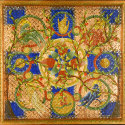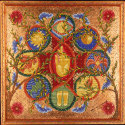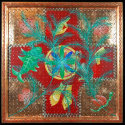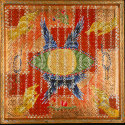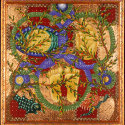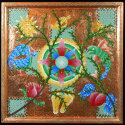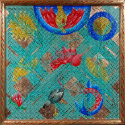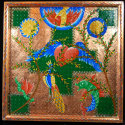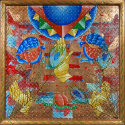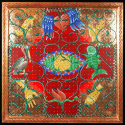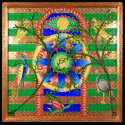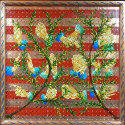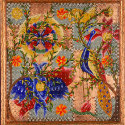 These works began as an extended meditation on Scripture and on the sense of eternity and the divine presence that I find in many traditional art forms – Islamic calligraphy and decorative motifs, illuminated manuscripts from Europe and North Africa, Greek and Russian icons, Moorish tile patterns, Gothic tracery, Celtic knot work, Chinese embroidery, and more – as well as in the gleam of flickering candles, or in a night sky filled with stars. Borrowing techniques and images from a variety of sources, I generally employ a limited palette of mineral pigments that might have been available to pre-industrial artists. Instead of the traditional egg tempera, however, I use a modern, acrylic medium that is somewhat more forgiving. The resulting clear, brilliant colors suggest to me a mystical world that is lit from within, defying the physical laws of gravity and optics.
These works began as an extended meditation on Scripture and on the sense of eternity and the divine presence that I find in many traditional art forms – Islamic calligraphy and decorative motifs, illuminated manuscripts from Europe and North Africa, Greek and Russian icons, Moorish tile patterns, Gothic tracery, Celtic knot work, Chinese embroidery, and more – as well as in the gleam of flickering candles, or in a night sky filled with stars. Borrowing techniques and images from a variety of sources, I generally employ a limited palette of mineral pigments that might have been available to pre-industrial artists. Instead of the traditional egg tempera, however, I use a modern, acrylic medium that is somewhat more forgiving. The resulting clear, brilliant colors suggest to me a mystical world that is lit from within, defying the physical laws of gravity and optics.
 While I am reluctant to assign a single, specific meaning to any of the motifs in these paintings, certain ideas have informed my choices. For instance, the fish image that is seen in several works is adapted from an Ethiopian illumination of the story of Jonah, combined with Japanese stylized renditions of carp, which are considered lucky in that tradition. The “great fish” in Jonah is connected to the Leviathan found in Job and the Psalms, as well as to the great sea creatures found in Genesis 1:21, at least in some translations. But in Isaiah 27:1, Leviathan is not a fish, but a serpent, like those found in both Genesis and Revelation. In these paintings, however, the fish, like the green snake with red wings –another quotation from the same Ethiopian manuscript – are not so much agents of evil as of the chaos which is the necessary condition for creation. If the hands in these paintings may be thought of as representing that which creates an orderly universe, then the fish and snake are the trickster elements – like Coyote of Native American lore, or Loki, of Norse mythology – that make life interesting. Order and chaos, beginning and ending, continually give way to one another in the creative cycle of the cosmos.
While I am reluctant to assign a single, specific meaning to any of the motifs in these paintings, certain ideas have informed my choices. For instance, the fish image that is seen in several works is adapted from an Ethiopian illumination of the story of Jonah, combined with Japanese stylized renditions of carp, which are considered lucky in that tradition. The “great fish” in Jonah is connected to the Leviathan found in Job and the Psalms, as well as to the great sea creatures found in Genesis 1:21, at least in some translations. But in Isaiah 27:1, Leviathan is not a fish, but a serpent, like those found in both Genesis and Revelation. In these paintings, however, the fish, like the green snake with red wings –another quotation from the same Ethiopian manuscript – are not so much agents of evil as of the chaos which is the necessary condition for creation. If the hands in these paintings may be thought of as representing that which creates an orderly universe, then the fish and snake are the trickster elements – like Coyote of Native American lore, or Loki, of Norse mythology – that make life interesting. Order and chaos, beginning and ending, continually give way to one another in the creative cycle of the cosmos.
The rhythm of beginnings and endings is hinted at by the trees or vegetal traceries that begin in the lower corners of each of the paintings, partially obscuring the layers beneath with their green and yellow leaves and reddish fruit. As the human story in Genesis begins in a garden, the last chapters of the last book of the Bible describe a beautiful, walled city, in the midst of which flows a river. “And on each side of the river stood the tree of life, bearing twelve crops of fruit, yielding its fruit every month. And the leaves of the tree are for the healing of the nations.” [Rev 22:2] The tree of life, first mentioned at the beginning of the human story, is now at the center of the holy city, in which everyone shall live in peace at the end of time.
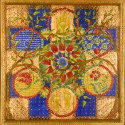 This layering of the tree of life over human and animal forms is but one of several strata in these paintings. I begin with a plywood panel, marked out in a geometric grid pattern, in which some squares are covered with copper leaf and others are painted a uniform color, such as ultramarine or yellow ocher or red oxide. These grids, often with alternating, cross-shaped patterns, remind me of the numerical game of magic squares, of the prescribed patterns for laying out playing cards for both amusement and fortune-telling, and of the many other grids and networks that humans devise to help them understand and control their lives. A final grid of dark and light dots overlays everything, and serves as the basis for a ragged, incomplete layer of Celtic knot work. As the various grids and layers interact with one another, sometimes a new meaning appears out of the accidental juxtaposition of otherwise unrelated elements, just as a moiré pattern emerges when two pieces of window screen are layered on top of one another.
This layering of the tree of life over human and animal forms is but one of several strata in these paintings. I begin with a plywood panel, marked out in a geometric grid pattern, in which some squares are covered with copper leaf and others are painted a uniform color, such as ultramarine or yellow ocher or red oxide. These grids, often with alternating, cross-shaped patterns, remind me of the numerical game of magic squares, of the prescribed patterns for laying out playing cards for both amusement and fortune-telling, and of the many other grids and networks that humans devise to help them understand and control their lives. A final grid of dark and light dots overlays everything, and serves as the basis for a ragged, incomplete layer of Celtic knot work. As the various grids and layers interact with one another, sometimes a new meaning appears out of the accidental juxtaposition of otherwise unrelated elements, just as a moiré pattern emerges when two pieces of window screen are layered on top of one another.
There are other motifs in these paintings – seraphim and birds and feet and sun and moon and stars and all-seeing eyes and the mystical compass rose and more – that continue to inhabit my imagination, even as they change colors and relationships under my hands. They emerge, like dreams or visions, from a place that is ruled by a different kind of logic than that of everyday life. Like mandalas or Tibetan tanka paintings, they function as an ever-changing map, describing an inner landscape where I am constantly losing and finding my way.


